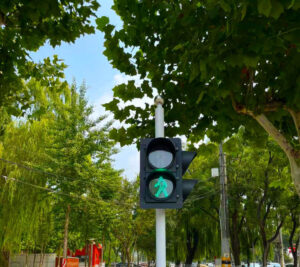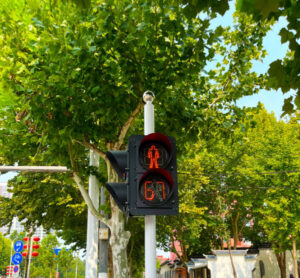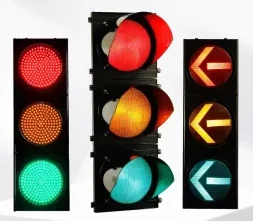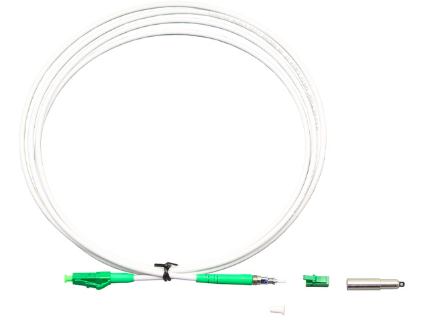What Are the Components and Working Principles of Stop Lights?
Home » What Are the Components and Working Principles of Stop Lights?
RECENT POSTS
Share:
- August 16, 2025
Table of Contents
Stop lights are an essential part of modern urban traffic systems, responsible for guiding traffic flow in a smooth and orderly manner while ensuring safety and efficiency. Whether on pedestrian crossings or at intersections, stop lights play a crucial role in maintaining safe and efficient traffic. This article will provide a detailed overview of the components, functions, and working principles of stop lights and discuss the importance of their optimization.
1. Basic Components of Stop Lights

Stop lights are typically made up of the following main components:
- Lamp Cover and Shell: The lamp cover protects the internal electronic components from external environmental factors (such as rain, dust, etc.), while also serving a reflective function to enhance the visibility of the stop light.
- Bulbs or LED Light Sources: Traditional stop lights use incandescent bulbs, while modern stop lights often use LED light sources, which are more energy-efficient and have a longer lifespan.
- Controller and Circuits: The controller and circuits act as the “central command” of a stop lightsystem, directing the sequence of light changes and ensuring the proper timing of signals. It processes data from sensors or pre-set schedules to regulate when each light should change, allowing for coordinated traffic flow.
- Traffic Detectors: Some advanced stop lightsystems are equipped with sensors and cameras to monitor traffic conditions at intersections, such as the number of vehicles and pedestrian activity, helping to optimize the switching time of the lights.
2. Working Principle of Stop Lights
Stop lights use three different colors—red, yellow, and green—to convey different traffic information. Each color represents different instructions:
- Red Light: A red light means “Stop.” Vehicles and pedestrians must stop and wait until the light turns green before proceeding.
- Green Light: A green light means “Go.” Vehicles can proceed, and pedestrians may cross the street.
- Yellow Light: A yellow light means “Caution,” signaling that the light is about to turn red, warning vehicles and pedestrians to prepare to stop or wait.
In traditional stop light systems, the switching time is fixed. However, with varying traffic volumes, many cities have begun using intelligent stop light systems that employ sensors and cameras to detect traffic flow in real time and adjust the switching time accordingly. Advanced stop light systems continuously monitor traffic conditions and dynamically modify signal timings. For example, when one direction experiences heavier traffic, the system can prolong the green phase to help ease congestion and improve flow.
3. Types of Stop Lights

- Standard Stop Lights: These are the most common type, typically featuring a red, yellow, and green light, and are used in simpler intersections.
- Pedestrian Stop Lights: To ensure pedestrian safety, modern urban stop lights often include pedestrian-specific signals. These signals typically show “Walk” and “Don’t Walk” to guide pedestrians when crossing the street.
- Left-Turn Stop Lights: In complex intersections, there may be dedicated left-turn stop lights to ensure safe passage for vehicles turning left. These lights are often represented by a green arrow, indicating that left-turning vehicles may proceed.
4. Development and Optimization of Intelligent Stop Lights
As urban traffic pressure increases, traditional fixed stop lights are no longer able to meet the demands of modern traffic volumes. To address this, intelligent stop lights have been developed. These smart systems continuously monitor traffic conditions and adjust light changes in real-time. For example, when traffic in one direction is heavier, the system can extend the green light duration to reduce congestion. Additionally, these systems can be linked to traffic monitoring platforms, providing real-time updates on traffic conditions and adjusting signal timings accordingly.
With the use of advanced data analysis, the system can predict traffic flow changes and dynamically optimize the light cycles. As cities grow and technology evolves, optimizing stop lights has become increasingly essential for improving traffic efficiency. The goal is to minimize vehicle wait times, enhance traffic flow, and reduce accident rates. The integration of vehicle-to-stop-light communication and the potential of autonomous vehicles will further drive the evolution of smart stop lights, providing even more flexibility and efficiency for urban traffic management.
Conclusion
Stop lights are fundamental in managing traffic, playing a key role in directing vehicles and pedestrians. By regulating traffic flow at intersections, they reduce the risk of accidents and enhance road safety, making them indispensable to effective and safe traffic systems. As technology advances, stop lights will continue to evolve towards smarter, more flexible systems, providing safer and more efficient travel environments for city dwellers.
0


